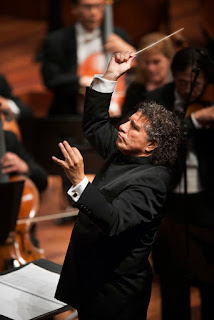Polish orchestra visits, with a much-laureled Western Hemisphere conductor on the podium
 |
| Giancarlo Guerrero showed his pizazz and control. |
Gesturally flamboyant and with an astute actor's range of facial expression, Guerrero had tempted me to draw the parallel throughout the scheduled program of Szymanowski, Bartok, and Brahms. But it was his showmanship in the two encores that cemented the comparison.
Just as Bernstein had stood vibrating and twitching while the orchestra with which he made his reputation dashed off his Overture to "Candide," Guerrero set aside conducting in all but a few places during predictably spirited accounts of Dvorak's Slavonic Dance No. 8 and Johann Strauss Jr.'s Thunder and Lightning Polka. In both cases, orchestras well attuned to the maestro could manage to run the course on autopilot. Guerrero went a step beyond during the Strauss romp, mugging, cuing the audience to listen for the thunderclaps (bass drum rolls), and looking skyward to make clear the mimicry of Mother Nature clearing her throat. Then he led the concertmaster by the hand off the stage, the universal signal that the evening's revels were over.
Guerrero and the large Polish orchestra (he also is music director of the Nashville Symphony) certainly presented a spectacular calling card after taking the stage. Karol Szymanowski, the first widely acknowledged Polish master composer after Chopin, was represented by his Concert Overture in E major, op. 12. He was clearly feeling his oats in his early 20s, and wrote this piece as if he were keen to sow some. The piece manages to be tidy while also bursting at the seams. The program note justly acknowledged the influence of Richard Strauss' thick but lively manner in his symphonic poems. In the main theme, I also heard something like the buoyancy and uplift characteristic of Edward Elgar, though it could be his English contemporary was not known to the young Pole. Shifts from heroic to lyrical moods were managed neatly throughout.
In the course of the program, it was a pleasure to take in the excellence of the orchestra—the strong profile it presented in brief wind solos, the solidity of the strings, and the particularly zealous playing of the timpanist, who helped put a seal on the powerful conclusion of Brahms' Symphony No. 1 in C minor. One of the few flaws I noticed in the NFM Wroclaw Philharmonic Thursday was the blurred onrush to the coda that sets up the C minor symphony's peroration. The excitement was not affected, but the coordination suffered. There was also a partly muffed entrance of the trombones as the long introduction to the first movement approached its end. The overall level of the performance had both the needed gravity, ingratiating zest, and the full-bore representation of the Brahmsian sound, including what one music critic once informally described to me as "Brahms' stomach rumblings." (Contrabassoonist, take a bow.)
Much used to be written about the timbral differences between European and American musicians, though the internationalization of classical music has muted such contrasts recently. Attempting to be alert to them, I noticed mainly that the oboe and English horn had a darker sound than I usually hear from our orchestras. And that bold timpanist produced a sound that seemed different, especially resonant even when the dynamic level was fairly low.
Piotr Anderszewski, the piano soloist, achieved a strikingly unified partnership with his countrymen in Bela Bartok's Piano Concerto No. 3. In the first movement, the tonally firm lower strings coordinated especially well with the piano, and the back-and-forth ending was delightful. Guerrero and Anderszewski achieved exquisite poise in the Adagio religioso second movement, with the pointillistic effects of a characteristically Bartokian "night music" episode delivered gracefully. Anderszewski's crisp articulation gave extra animation to the finale, and the orchestra matched him in crispness and momentum.
Guerrero, whose career distinctions include six Grammy Awards, is well enough his own man not to need comparisons with Bernstein, of course, whether favorable or not. There are distinct differences just from a visual standpoint: He is less focused on shaping filigree than Bernstein was, and he thrusts his hands high with an often clarifying, less ecstatic angularity. In the Brahms, he eschewed score and baton. He oozes self-confidence and, what is even more valuable in conductors, genuine mastery. That was generally the rule in this splendid concert.



Comments
Post a Comment